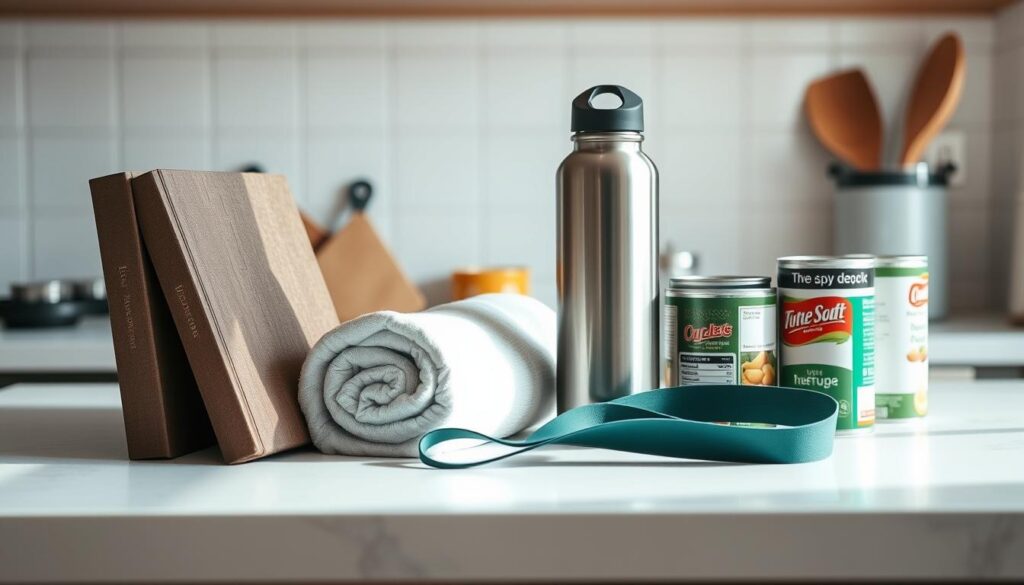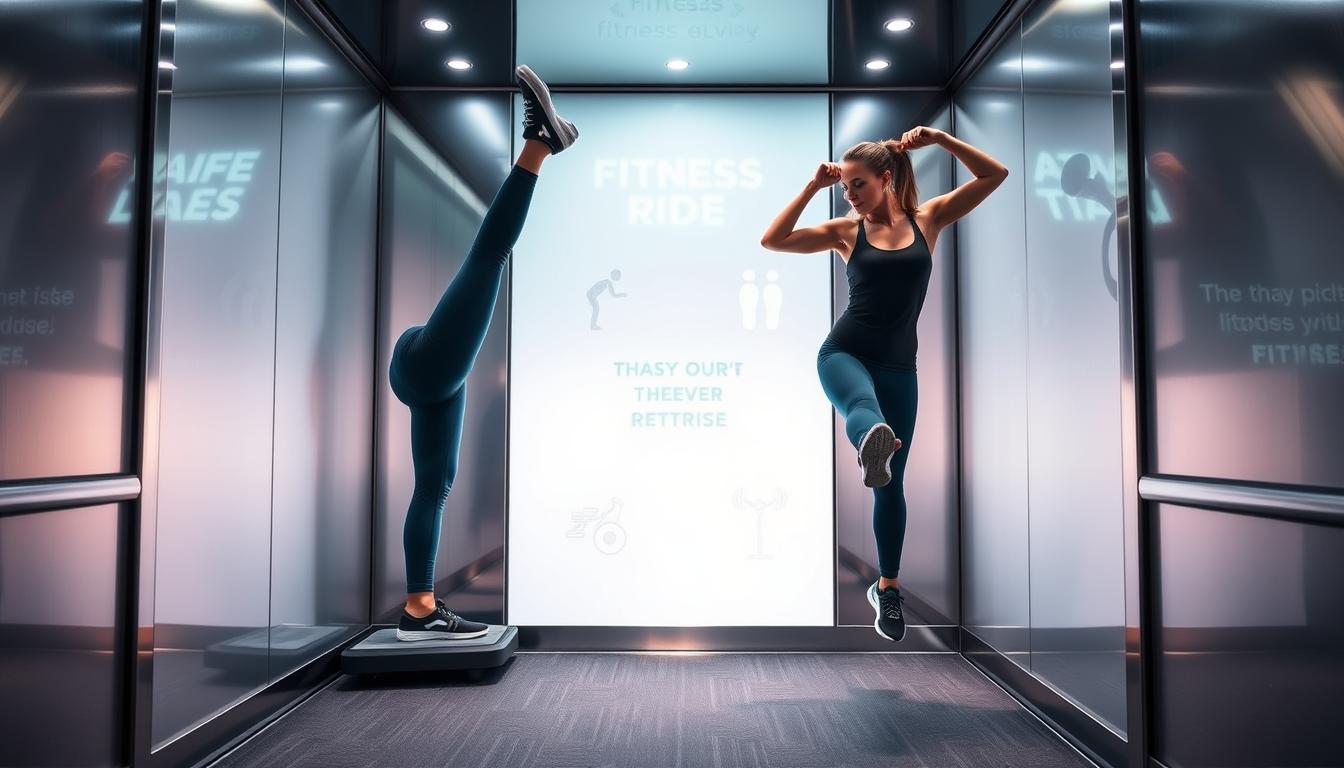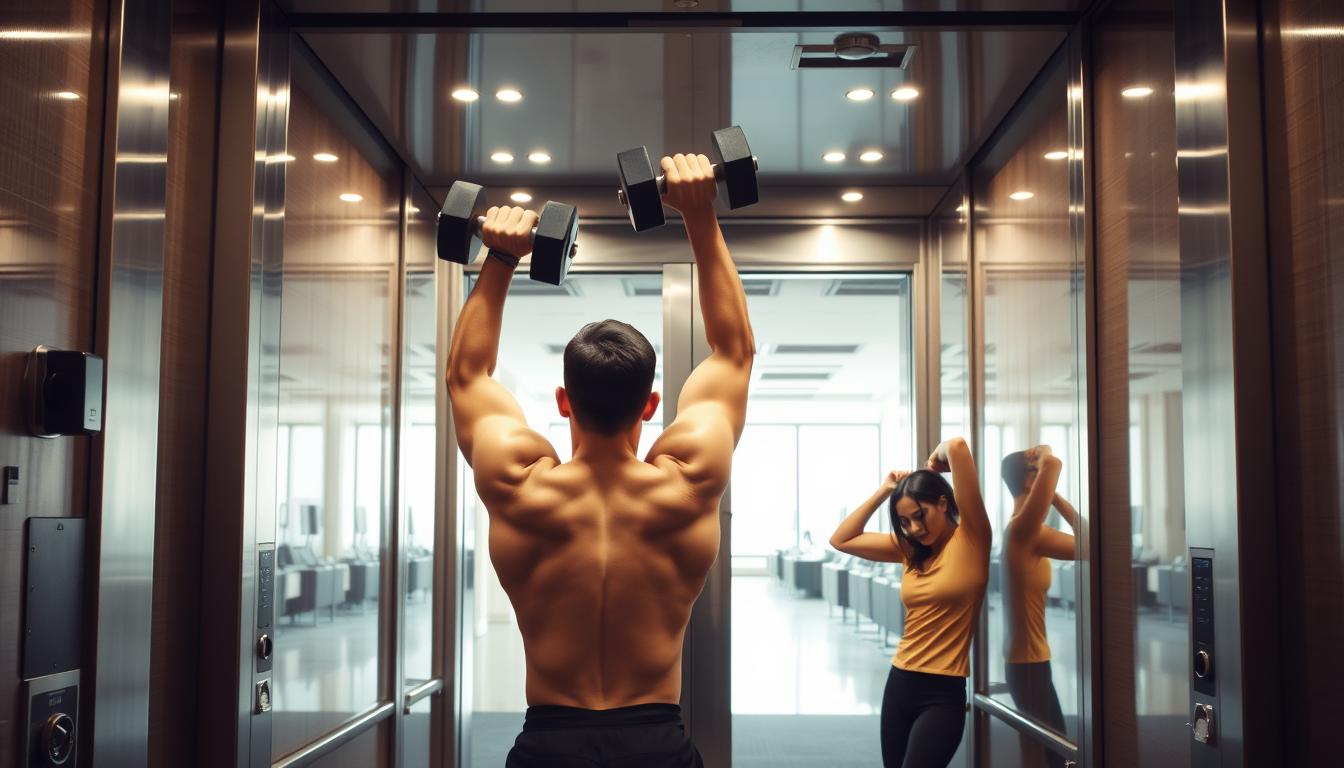Nowadays, many people are finding out how great small space workouts are. They are perfect for those who want to exercise at home but don’t have much space. This change lets people transform their small living areas into places where they can stay fit without needing a lot of room or big machines.
There are many ways to workout in a small area, like using resistance bands. Or doing bodyweight exercises like squats, lunges, and push-ups. These types of workouts don’t take up much space but still get great results. They help you burn calories and get stronger right in your living room. For instance, if you weigh 160 pounds, you can burn over 350 calories in just 30 minutes by jumping rope.
Whether you want to get stronger with kettlebell exercises or improve your stamina with indoor cycling, there’s a workout for everyone. Even in tight spaces, it’s possible to have a great fitness routine.
Introduction to Small Space Workouts
Small space workouts have become more popular, especially during the pandemic. They show you don’t need a big space to stay fit. They offer benefits like saving time and keeping workouts private. This makes it easy for folks to stay active every day.
Adding items like dumbbells or resistance bands can make home workouts better. If you prefer not using equipment, try push-ups, squats, and lunges. They need little room. Yoga and barre are great for quiet, equipment-free exercises too.
Making a cozy spot for your workouts is important. An exercise mat can make floor exercises more comfortable and quiet. Using wireless headphones lets you keep workout sounds low. By focusing on the right movements and planning, anyone can get fit, even in small spots.
Why Working Out in Small Spaces Is Effective
Many think you need a big area to exercise well at home. But, small spaces offer big benefits for fitness, too. Using your bodyweight for training works great in tight spots. It lets you get strong and fit without needing a lot of room or gear.
Bodyweight exercises fit well in small places and include moves like squats, lunges, and push-ups. These activities work several muscle groups at once and improve balance. Adding common items, like towels or doorways, can up the challenge. For example, doing rows with a towel adds some resistance.
Starting with simple exercises and gradually adding harder ones creates effective workouts. You might begin with short sessions of jumping jacks, push-ups, squats, and mountain climbers. Then, add high knees, explosive push-ups, and jumping lunges to keep improving your fitness.
Keeping good form is key to getting the most out of small-space workouts. It ensures you’re working out efficiently and safely. When you focus on how you move, even exercises in tight spots can bring great results. By making the most of small spaces and bodyweight exercises, anyone can build a powerful workout routine at home.
How to Set Up Your Workout Space
Turning a small spot into a workout area takes thoughtful planning. Choosing the right items can boost your motivation and results. Aim for home gym must-haves that fit well and allow for a range of exercises.
Choosing the Right Equipment
Look for gym tools that are both compact and versatile. The PR-4100 Folding Squat Rack is perfect. It mounts on the wall and folds away, saving space but strong enough to support heavy weights. Add the AB-4100 Adjustable Bench for versatility in a small footprint. Then, include QuickDraw® Adjustable Dumbbells that adjust from 5 to 60 pounds. They come with a storage cart for neat organization and varied strength workouts.
Utilizing a Yoga Mat
A yoga mat is crucial for your workout zone. It protects you during floor exercises and keeps noise low. This simple piece makes a space comfy for stretching, core work, and bodyweight exercises, vital for a full workout plan.
Investing in Wireless Headphones
Wireless headphones make exercising better by letting you move easily. They’re key for keeping up your spirits with music or instructional audio, crucial in snug spaces. Good headphones also make sure your workouts don’t bother others nearby.
Essential Bodyweight Exercises for Small Spaces
Bodyweight exercises are key for great workouts in tight spots. You can get stronger and fitter without lots of gear. We’ll look at important moves like push-ups, squats, lunges, and more. These basics make workouts safer and more effective, helping you stay healthy for longer.
Push-ups Variations
Push-ups come in over 30 types, hitting different muscles. The classic push-up works your chest, shoulders, and arms. But, you can change it up with incline or decline versions for more challenge. Mixing in styles like diamond or wide-grip keeps your exercises fresh and works all parts of your muscles.
Squats and Lunges
Squats and lunges fit well in any small area and offer big benefits. Squats power up your legs and butt, making you stronger and more bendy. Lunges boost your balance and focus on the same muscles, with moves like front and reverse lunges to spice things up.
Planks and Mountain Climbers
Planks are all about core strength and not moving. You can try side or forearm planks for extra work. Mountain climbers mix things up, giving you a heart-pumping, full-body exercise. These moves make sure you get a well-rounded workout, even in a small space.
Tips for Quiet Workouts
Living in an apartment or a house with shared walls makes quiet workouts a challenge. Using noise reduction techniques helps you avoid bothering neighbors and stay focused. Here are some tips to exercise quietly but still warm up and cool down effectively.
Minimizing Noise with Proper Techniques
- Use a thick exercise mat to absorb sound. It reduces noise from your movements.
- Wear headphones to keep your music or videos to yourself, lowering noise.
- Stay away from loud cardio like jumping jacks. Try quieter moves like squat kicks or kettlebell swings instead.
- Add resistance bands for silent strength training. Moves like lateral raises are quiet and effective.
- Try quiet bodyweight exercises, like counter push-ups or standing calf raises. These make less noise.
Warm-Up and Cool Down Considerations
Start your workout with a good warm-up. Gentle stretches or Sun Salutations in yoga get you ready without noise. After exercising, cool down with stretches or relaxation to prevent injury and aid recovery.
Use low-impact PiYo moves for muscle building with less noise. Strengthening your core with moves like bicycle crunches and planks is also quiet.
Mastering Functional Movements
Functional movements are the core of great workouts, especially in small spaces. Learning how to do push, pull, squat, hinge, and lunge moves is key. This knowledge boosts your fitness and makes daily activities easier.
Understanding Push, Pull, Squat, Hinge, and Lunge Movements
Getting good at these basic movements helps a lot in workouts and daily life. The bodyweight squat, for example, strengthens legs and improves mobility without any gear. It’s perfect for small spaces.
Then there’s the prisoner get-up, which makes your lower body stronger and more mobile, using just your bodyweight. And the jump squat increases power and strength, needing very little room.
Applying Functional Movements in Your Routine
Adding functional movements to your workouts boosts balance, strength, and coordination. Take the mountain climber; it mixes cardio and core training, great for small areas.
Then there’s the plank bird dog, which strengthens your core in any space. Adding moves like the forward lunge with rotation improves balance without equipment. And the lateral lunge works on hip mobility, making you fitter overall.
Exercises like the dumbbell bent-over row and hand-release push-up work many muscles at once. They copy real-life actions, building functional strength and better coordination.
Being flexible with your small space workouts lets you be creative. This helps you focus on functional movements. Whether it’s through intense intervals or versatile exercises, aiming for functional movements is a fitness game-changer.
Exercises for Small Spaces
Staying active in small areas is easy. You don’t need a lot of space or equipment for a full-body workout. Try these bodyweight routines to fit exercise into your busy life.
Bodyweight Squats
Bodyweight squats work your legs and butt. Start with your feet apart, bend your knees, and keep your upper body straight. Push up from your heels to stand. They’re great for tight spaces.
Glute Bridges
Glute bridges focus on your butt and core. Lay down, bend your knees, and keep feet flat. Lift your hips high, squeezing your glutes, then lower. They’re key for a strong backside, no heavy equipment needed.
Tricep Dips Using Household Items
Tricep dips shape your arms and shoulders. Use a chair or a table. Sit, hands by your hips, and lower your body, then push up. It’s a smart way to use home items for fitness.
Using Household Items as Equipment
Everyday items can turn into effective workout tools. This makes your home exercises better without needing to buy gym gear. Using items like towels and chairs lets you do strength training and get great results, even in limited spaces.
Creative Alternatives for Resistance Training
You can find many things at home to use in workouts. Here are some cool ideas:
- Light Dumbbells: These are affordable and easy to store, great for adding resistance to exercises.
- Laundry Detergent Jugs: Use these for arm workouts instead of dumbbells; they’re heavy enough for effective exercise.
- Cans of Soup: Perfect for arm workouts like bicep curls and tricep kickbacks.
- Full Backpack: Load it with books to add resistance during squats or wall sits.
- Resistance Bands: They’re compact and great for both toning muscles and improving flexibility.
Incorporating Towels and Chairs
Simple items like towels and chairs can make exercises better. Try these tips:
- Hand Towels: Use them as sliders for ab workouts or as makeshift resistance bands.
- Chairs or Stools: Great for tricep dips, step workouts, or barre exercises using the back for support.
- Laundry Baskets: Lift a full basket for squats or use as extra weight during wall sits.
- Sliders: Paper plates work as sliders for moves that tone your body and improve abs.
By using home items in your workouts, you stay smart and find fun ways to do resistance training. With some creativity, your usual objects can help you meet your fitness goals.

Low-Impact Workout Ideas for Quiet Environments
If you live in a small place or just want to keep things quiet, low-impact workouts are perfect. They’re easy on your joints and don’t make much noise, but you’ll still get a good workout. Yoga is great because it’s calming, builds strength, and makes you more flexible. Barre exercises need very little gear, so they’re awesome for small spaces.
Yoga Practices for All Levels
Doing yoga in tight spaces is a quiet way to get stronger and more limber without bothering your neighbors. Start with Sun Salutations to wake up your core. They’re good by themselves or as part of your warm-up. Quiet moves like seated stretches and easy twists are perfect. To warm up without noise, try swinging your arms and legs.
Barre Workouts in Small Spaces
Barre mixes ballet and isometric holds for a quiet, effective workout, focusing on your core and legs. Try plié squats without heavy weights for less noise. Use a solid piece of furniture for support to make the most of a small area. Resistance bands can spice up your routine without adding noise.
Strategies to Stay Motivated
Finding ways to stay motivated in your workouts is key. It starts with setting good goals for fitness. When you know your fitness goals, you really care about reaching them. Setting goals you can achieve helps you stay driven and succeed.
Setting Realistic Goals
First, figure out why you want to exercise. This makes your workout journey mean more. Think about these tips:
- Use sticky notes with positive messages about your goals. Put them where you can see them.
- Start with small exercise steps, like a 10-minute warm-up, to gain momentum.
- Choose fitness goals that are within your reach. This helps you keep focused.
Creating a Structured Workout Program
A structured plan for your workouts can make you more consistent and motivated. Follow these ideas to keep your routine:
- Make a space just for your workouts. This helps you focus and avoid distractions.
- Use fitness apps that offer workouts for small areas. Try yoga or bodyweight exercises.
- Plan your workout times. Break them into parts you can manage easily.
- Work out with a friend for support and to keep each other on track.
- Change up your routine to keep things interesting and avoid getting bored.
These steps not only help you keep up with your workouts. They also let you see your progress. This boosts your dedication to reaching your fitness goals.
Gradually Increasing Workout Intensity
Boosting workout intensity is key for reaching fitness goals. By using progressive overload, people can keep challenging their bodies and bypass plateaus. It’s crucial to carefully increase intensity, ensuring steady fitness progress and better performance over time.
Incorporating Progressive Overload Techniques
Progressive overload is about slowly stepping up exercise challenge or resistance. For starters, a routine with 10 exercises like bridge, chair squat, and knee pushup works well. Begin with two sets of 10-15 reps, resting 30 seconds to 1 minute between.
Once fitness improves, move on to intermediate routines. Do each exercise for 1 minute, then rest 1-2 minutes before going again.
For advanced stages, try tougher variations like single-leg bridges or overhead squats. Doing two sets of 10-15 reps with proper rest helps avoid injury and ensures muscles work hard enough.
Monitoring Your Progress and Adjusting Goals
Keep an eye on fitness progress to stay on track. Assessing how you perform lets you tweak goals based on what you achieve. If an initial weight becomes too easy after doing more than 15 reps, it’s time to up the resistance.
Changing rest times between sets or making exercises harder boosts progressive overload. These changes make workouts better and help with consistent fitness growth. Remember to rest up one full day between strength sessions to maximize results and adapt well to more intense workouts.
Conclusion
Working out in a small space can be both fun and effective. You don’t need a lot of room to stay fit. Using bodyweight exercises, adjustable dumbbells, and resistance bands offers great workouts. Experts suggest adults should do 150 minutes of moderate exercise and strength training twice weekly.
Adding short workouts throughout your day can improve your mood and blood pressure. Even busy people can benefit from these exercises. Organizing your workout area with foldable gear and inspiring decorations helps keep you on track. With dedication and the right equipment, achieving fitness goals in a tiny space is totally possible.
Fitness is all about staying committed and being regular, not the size of your workout area. A small space workout plan should mix effective exercises and useful advice. It lets you lead a fit life without disrupting your daily routine.



